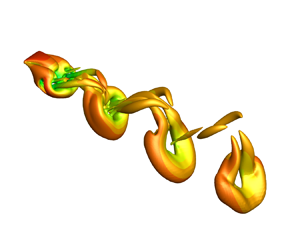No CrossRef data available.
Article contents
Dynamics of weighted flexible ribbons in a uniform flow
Published online by Cambridge University Press: 14 August 2024
Abstract

This study explores the dynamics of flexible ribbons with an added weight  $G$ at the tail in uniform flow, considering key parameters like inflow Reynolds number (
$G$ at the tail in uniform flow, considering key parameters like inflow Reynolds number ( $Re_u$), mass ratio (
$Re_u$), mass ratio ( $M_t$) and aspect ratio (
$M_t$) and aspect ratio ( ${A{\kern-4pt}R}$). For two-dimensional ribbons, a simplified theoretical model accurately predicts equilibrium configurations and forces. Inspired by Barois & De Langre (J. Fluid Mech., vol. 735, 2013, R2), we introduce an important control parameter (
${A{\kern-4pt}R}$). For two-dimensional ribbons, a simplified theoretical model accurately predicts equilibrium configurations and forces. Inspired by Barois & De Langre (J. Fluid Mech., vol. 735, 2013, R2), we introduce an important control parameter ( $C_G$) that effectively collapses normalized forces and angle data. Vortex-induced vibration is observed, and Strouhal number (
$C_G$) that effectively collapses normalized forces and angle data. Vortex-induced vibration is observed, and Strouhal number ( $St$) scaling laws with
$St$) scaling laws with  $C_G$ are identified. In three-dimensional scenarios, the model effectively predicts lift, but its accuracy in predicting drag is limited to situations with small
$C_G$ are identified. In three-dimensional scenarios, the model effectively predicts lift, but its accuracy in predicting drag is limited to situations with small  $Re_u$ values. The flow along the side edges mitigates pressure differences, thereby suppressing vibration and uplift, particularly noticeable in the case of narrow ribbons. This study offers new insights into the dynamics of flexible bodies in uniform flow.
$Re_u$ values. The flow along the side edges mitigates pressure differences, thereby suppressing vibration and uplift, particularly noticeable in the case of narrow ribbons. This study offers new insights into the dynamics of flexible bodies in uniform flow.
JFM classification
- Type
- JFM Papers
- Information
- Copyright
- © The Author(s), 2024. Published by Cambridge University Press



